After completing the necessary documents for the shipment of your cargo, it’s now ready for its next air import procedure adventure. It’s valuable to understand what happens next and who is responsible for what, especially for first-time importers. A simple guide, showing the next steps your cargo undergoes during the air import procedure, will illustrate.
Air import procedure overview
Not all airports are highly automated when it comes to handling and processing imported air cargo. In most airports, imported air cargo handling is done manually, following one of three processes.
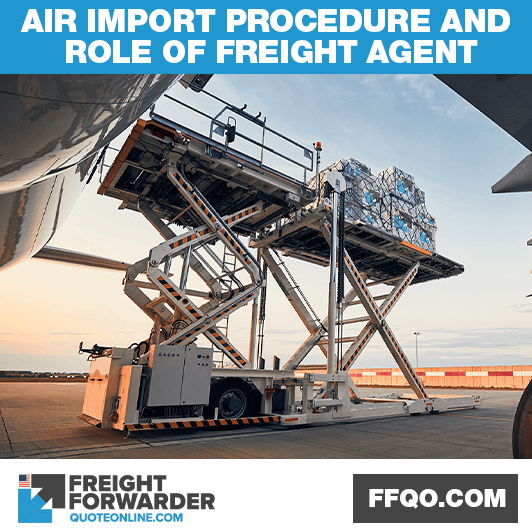
Air import procedure and the role of freight agent handling cargo
Regular air import procedure
The regular air import procedure is composed of these three major sections:
Transfer from landside to airside
- Unloading of truck
- Incoming checks and administration
- Sorting of goods and documents
- Outgoing checks and administration
- Build unit load device (ULD)
Transfer from airside to airside
- Ramp transport and security check
- Loading of ULD into the aircraft
- Flight
- Unloading of aircraft
- Ramp transport
Transfer from airside to landside
- Breakdown of ULD
- Incoming checks and administration
- Sort goods and documents
- Outgoing checks and administration
- Load truck
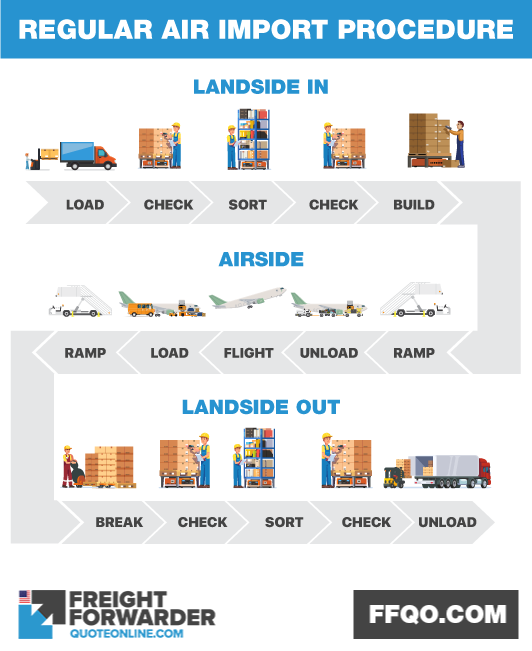
Regular air import procedure for cargo
Air transit shipment procedure
At times, freight forwarders may request an air transit shipment to speed up delivery of your goods. This skips some steps, resulting in a faster process flow.
Transfer from landside to airside
- Flight
- Unloading of aircraft
- Ramp transport
Transfer from airside to airside
- Breakdown of ULD
- Incoming checks and administration
- Sort goods and documents
- Outgoing checks and administration
- Build ULD
Transfer from airside to landside
- Ramp transport and security
- Load aircraft
- Flight
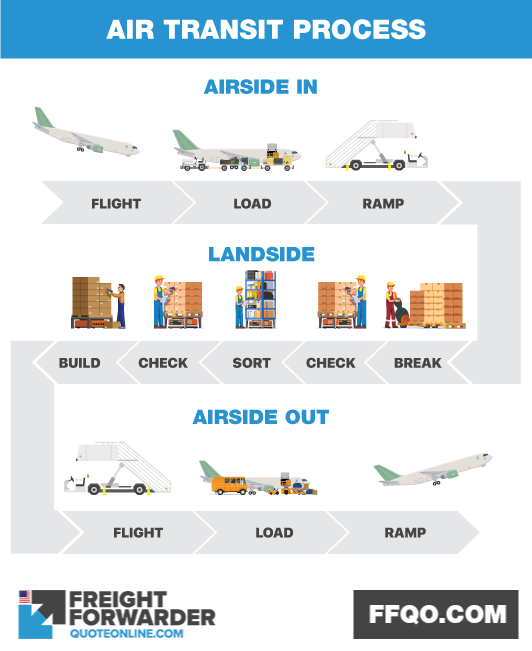
Air transit procedure for imported cargo
Priority air procedure
In general, the air import procedure is simplified as much as possible in order to make processing fast and straightforward. The stages include:
- Flight
- Unloading of aircraft
- Ramp transport and security
- Load aircraft
- Flight
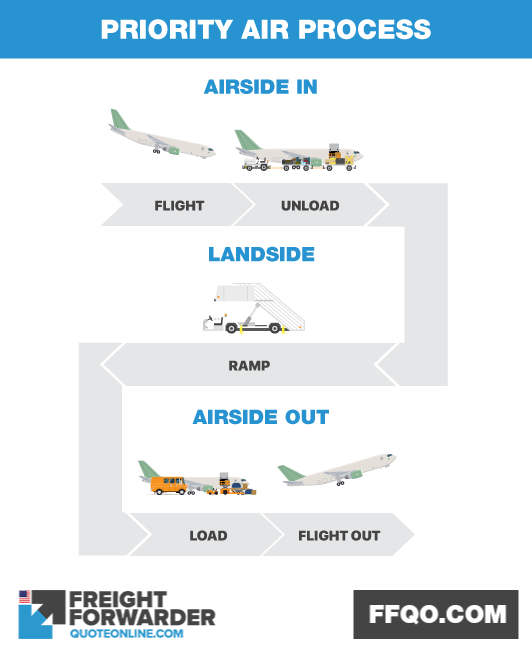
Priority air process for imported cargo
Getting to know the freight agents handling your cargo
All of these processes have an equivalent rate. You, as the owner of the cargo, always have the final word on which option to choose. However, always remember to consider the following factors:
- Price
- Flight schedule
- Cargo requirements
What roles do handling agents play in the air import process?
Cargo handling can be an in-house function of an airline for commercial service. In most cases, however, airlines have independent contract agents to handle the importing.
So who are these handling agents?
Freight agents handling your imported cargo are the people who look after your cargo personally during its arrival, stay and departure from the airport. This includes tasks such as:
- Controlling the weight and balance of cargo on the aircraft by checking the load sheet to ensure flight safety
- Preparing a cargo manifest for your cargo on board for customs declaration
- Notifying the aircraft captain re potential risks in relation to your cargo, and the necessary conditioning required for the cargo while on board
- Planning and controlling booking, slot-time, desired flows in the stock house, ULDs and flight bag to ward off delays and ensure correct implementation of the airline’s timetable
- Planning and controlling the worldwide Unit Load Device (ULD) stock
These freight agents are very busy and work hard to ensure they finish their tasks promptly.
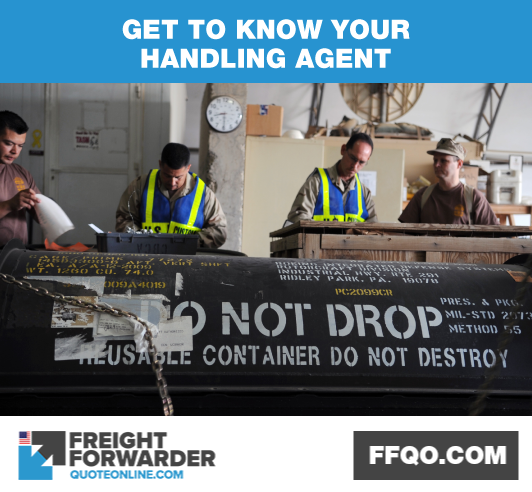
Role of the freight agent handling cargo in the air import procedure
Time before departure (TBD) of the aircraft
Prior to your cargo’s departure some things must be prepared by your handling agents.
Commercial checks
Checks of the booking and calculation of physical details of your cargo are performed, including number and volume, to ensure everything is in order.
Logistics checks
Documents are checked to ensure cargo is ready for carriage (RFC).
Flight safety checks
Before the departure of any cargo it is important the following flight safety checks are conducted:
- Proper cargo packaging
- Hazardous materials visibly labelled
- Cargo documents
Security checks
Another aspect to consider, as part of the handling agent’s checklist, is to ensure the declared forwarder and shipper are listed and that the packaging of the documents has been double-checked.
After submitting all these, your cargo and its documents will go their separate ways, but are still connected by labels. Both will be handled and administered separately and stored temporarily.
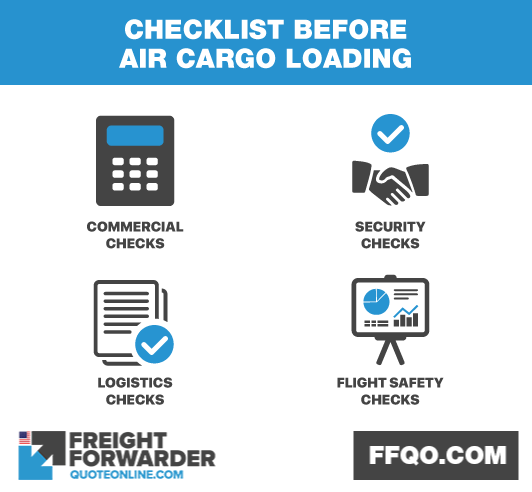
Four things to consider before air cargo loading shown on this checklist
Time before arrival (TBA) of the aircraft
Prior to your cargo’s arrival at the destination airport, handling agents pre-alert or send a freight forwarding message (FFM) to their co-handling agents via electronic devices. These provide details of your cargo and its flight.
While awaiting for your cargo’s arrival the receiving handling agent prepares the receipt of your cargo’s shipment. This includes planning the division process of ULD to ensure your cargo’s smooth flow.
Arrival of cargo at the destination airport
After your cargo’s safe arrival at the airport your shipment has to undergo a similar procedure, as illustrated in the three different air import procedures. These are the regular, transit and priority. At this stage, however, this section of the process is now done in reverse.
When your cargo and the flight bag are already settled in the airport, ULDs will be at the stock house and the flight bag in the office. The cargo is then cleared through customs. The receiving forwarding agent then notifies the handling agent that your cargo and documents are now ready to be released.
Do you need help with the air import procedure?
For additional questions regarding air import procedure, call us at 1-877-901-2004. We are always ready to help you. We can help advise the best air import procedure for your cargo will and organize freight agents to handle the shipment. We know these people play a critical role in your cargo’s transportation. Follow our LinkedIn Company page. Otherwise, check out our freight updates for imports and exporters to find more items around the air import procedure.




